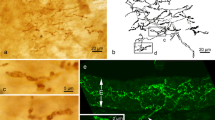Summary
The secretory nerves enter the tubule epithelium at the level of the gland hilus. Their subdivisions being located between the epithelial cells or their infoldings, have always extracellular position. Satellite cells still surround the largest axon bundles, but are no longer discernable round the smaller bundles or isolated axons which are thus in direct apposition with glandular cells. Neuro-glandular synapses, with asymetric membrane specialisations similar to those found in the central nervous system of vertebrates, have been found. The varicose secretory fibers contain various types of vesicles, similar to those found in the secretory or the motor trunks at the duct level, or in the gland motor fibers. The significance of these vesicles is discussed, in reference to the possible existence of various biogenic amines in the nerve fibers.
Résumé
Les nerfs sécréteurs pénètrent dans l'épithélium des tubules au niveau du hile de la glande. Leurs subdivisions se disposent entre les cellules épithéliales ou leurs replis, et gardent toujours une situation extracellulaire. Les plus gros faisceaux d'axones sont encore entourés par des cellules satellites qu'on n'arrive plus à discerner autour des faisceaux moins importants ou autour des fibres isolées. Les axones sont alors directement au contact des cellules glandulaires. On a pu trouver des synapses neuro-glandulaires avec des spécialisations membranaires asymétriques comparables à celles décrites dans le système nerveux central des Vertébrés. Les fibres sécrétrices variqueuses contiennent d'autre part des vésicules de types variés, semblables à celles des troncs sécréteurs et moteurs du canal, et à celles des fibres motrices de la glande. La signification de ces vésicules a été discutée en relation avec l'existence possible d'amines biogènes diverses dans les fibres nerveuses.
Similar content being viewed by others
Bibliographie
Azzi, A.: Sulla fine struttura della ghiandola salivare posteriore di Octopus macropus. Arch. ital. Anat. Embriol. 16, 246–258 (1917).
Ducros, C.: L'innervation des glandes salivaires postérieures chez Octopus vulgaris. Arch. Anat. micr. Morph. exp. 60, 27–36 (1971a).
Ducros, C.: Etude histochimique de la distribution des amines biogènes dans les glandes salivaires postérieures de céphalopodes. Arch. Anat. micr. Morph. exp. 60, 407–420 (1971b).
Ducros, C.: Etude ultrastructure de l'innervation des glandes salivaires postérieures chez Octopus vulgaris. I. Les troncs nerveux du canal salivaire. Z. Zellforsch., sous presse (1972a).
Ducros, C.: Etude ultrastructurale de l'innervation des glandes salivaires chez Octopus vulgaris. II. Innervation de la musculature du canal et des glandes. Z. Zellforsch., sous presse (1972b).
Gray, E. G., Guillery, R. W.: Synaptic morphology in the normal and degenerating nervous system. Int. Rev. Cytol. 19, 111–182 (1966).
Hand, A. R.: Nerve — acinar cell relationships in the rat parotid glands. J. Cell Biol. 47, 540–543 (1970).
Krause, R.: Über Bau und Funktion der hinteren Speicheldrüsen der Octopoden. S.-B. Akad. wiss. Berlin 51, 1085–1098 (1897).
Martin, R., Barlow, J.: Localisation of monoamines in nerves of the posterior salivary gland and salivary centre in the brain of Octopus. Z. Zellforsch. 125, 16–30 (1972).
Matus, A. I.: Histochemical localization of biogenic monoamines in the posterior salivary glands of octopods. Tissue and Cell 3, 389–394 (1971a).
Matus, A. I.: Fine structure of the posterior salivary gland of Eledone cirrosa and Octopus vulgaris. Z. Zellforsch. 122, 111–121 (1971b).
Rawitz, B.: Über den feineren Bau der hinteren Speicheldrüse der Cephalopoden. Arch. mikr. Anat. 39, 596–611 (1892).
Author information
Authors and Affiliations
Rights and permissions
About this article
Cite this article
Ducros, C. Etude ultrastructurale de l'innervation des glandes salivaires postérieures chez Octopus vulgaris . Z.Zellforsch 132, 67–78 (1972). https://doi.org/10.1007/BF00310297
Received:
Issue Date:
DOI: https://doi.org/10.1007/BF00310297




